|
|
Melbourne's weather can be capricious. As my cousins, Noelene and Lionel Beardsley, my Aunt Cynthia Deatker and I drive into the city on the evening of January 4th, we are greeted by surly skies and a chilly drizzle. It doesn't auger well for the outdoor Reunion "Meet and Greet" kick off scheduled for the following morning.
Once inside the foyer of our Short Stay Apartments, however, the cheerless weather recedes into the background. The hall is packed with arrivals at the check-in counter and the room is buzzing with animated conversation - all of it in unmistakable Anglo-Indian accents. A tap on my shoulder and there's Rhyllis, Corrine and Roland McCarthy from our British Columbia Recreational Club, all of them beaming. As we greet one another, another voice says, "Margaret! Finally we meet in person!" It's Lynne Rebeiro, editor of Anglo-Indians in Touch based in Toronto, and we both break into delighted grins. Lynne points out several other A.I. Torontonians chatting in a group at the far end of the hall, and just beyond them I catch sight of Blair and Ellen Williams (Blair is at the flagship of the Calcutta Tiljallah Relief Fund) smiling and waving to us across a sea of heads.
"Hey...there you are!" Bernadette Earle ("Bunny" to the family)and her husband Paddy, break through the throng and envelops us all in hugs. She is my aunt, Cynthia Deatker's youngest sister, and technically speaking also an "aunt" - but as far as Noelene and I are concerned, more like a contemporary "cousin". In tow are Anita and Noel Wallace - connected to me via the Deatker family's marriage links.
The Reunion, as far as I am concerned, has already begun!
The following morning dawns clear and blue-skied. We alight from our car at Albert Park to join a river of people moving towards to the entrance of the Meet and Greet area. There is a palpable sense of anticipation running through the crowd, as we converge onto a huge enclosure, dotted with gaily coloured tents - a precaution against rain, but today providing welcome shade from a blazing sun. I stand for a moment, incredulous at the sheer numbers milling across the lawns - over two thousand folks drawn from every corner of the globe, gathered to celebrate our unique identity, our common heritage and background.
Most of us here this afternoon, are part of a generation who lived through the traumatic years on the cusp of India's independence; we share a collective memory of the dust and heat of summer afternoons on the plains, have all worn school ties, blazers and tunics and have snacked guiltily on forbidden "chaat" from sidewalk vendors outside our school gates. Our words are still tinged with Anglicized Hindi pronunciations - "doll" (and rice), "bochi-khana" and "bandobast". And we all instantly know what a "doolie" or a "surahi" or a "morah is - and what a "rumble-tumble" egg looks and tastes like.
We settle into seats under a marquee, and snippets of conversation float over to us: A stocky balding man is saying earnestly to a lanky guy in dark glasses: "...so did you know "Budda" Green? Yeah, yeah, that's the same guy...retired from the Railways..." Much nodding and agreement - and then the inevitable comment, "Small world huh!"
That it certainly is. I lean over to Noelene and say: "This is unreal! I feel as though I'm not only in a small world - I'm enveloped in a separate - and very different world. It's Anglo-India encased in a bubble - blown enormous and floating high. But one which will burst at the end of this week, and we'll all be dispersed once again - fragmented - into the far corners of the earth!"
An excited shriek makes us turn in our seats. A woman breaks away from a nearby group and grabs a passerby. "Marleeeeene!" she screams, "Oh my God, I can't believe it's YOU!" Marlene looks equally stunned and then bawls back, "Angela!" The two women hug one another as they jig around in a circle, laughing.
In the opposite direction, there is a loud guffaw! Noelene, Lionel and I swivel heads. Two guys are whacking each other on the back. "Bloody-hell Bob!" one of them exclaims, "Hey man, is it good to see you again!" He turns and bawls in the direction of his wife, "Connie, you're not going to believe this! Look who the hell's here!"
Lunch is announced and we form crocodiles toward two tents - chatter snaking along both lines. The buffet includes pea pullau, chicken curry (cooked Anglo-Indian style), kati rolls, raitha and an array of green salads. It all smells marvellous. And it tastes no less so!
All through the Meet and Greet show, the MC has been busy at the mike. There are numerous announcements for 'so-and-so' to please come forward as 'your old buddy, so- and-so' is looking for you! Entertainers sing lustily as we chow our way through lunch. The rhythm hits high gear after the meal is over. Old favourite jive numbers ("Hey be-pop-a-lula, she's mah baby!") attract a host of people up to the grassy "dance area". I am thrilled - they are all jiving in typical Anglo-Indian style and I can't resist it when a stranger offers me his hand in invitation.
But, "stranger" isn't an appropriate word at this Reunion. None of us are strangers at all - we are striking high fives with people we've never met before in an extraordinary and spontaneous across-the-board spirit of camaraderie.
When the MC announces that we have to close for the afternoon, a groan of "ohhhh" goes up. However, the next event looms - a multi-cultural concert that evening at Monash University.
If the Meet and Greet was a resounding success, I have to admit to running out of superlatives to describe the Multicultural concert. Although the show opens with a colourful Aboriginal dance and includes a snappy Celtic dance number, as well as a meticulously executed traditional South Indian dance, most of the program showcases Anglo-Indian talent - crooners, pianists, jazz ensembles and stand up comedians. Marie Wilson, a well known Anglo-Indian jazz singer in Australia, leads off with a selection of popular standards, and earns an enthusiastic round of applause. Half way through the program, an attractive, slim young crooner, Candice Salmon, takes the spotlight. Her voice is smooth, the lower notes rich and mellow and the higher notes clear and pure. The audience goes wild and gives her a standing ovation. Shortly afterwards we are treated to a skit by "Indian magician", Russell John - complete with a babu accent, and a servile "bearer" as his assistant. The familiar "Hinglish" phrases convulses the audience into roars of laughter and thunderous applause.
During the intermission we collect our "tiffin" dinner, and I stand chatting to the McCarthys when to Rhyllis' vast amusement I am addressed (in typical Anglo-Indian respectful fashion) as "Auntie" by a man in mid-forties, who offers me his chair. "Auntie, Auntie, go, go!" Rhyllis splutters between giggles. I decline his offer of a seat, but he notices me struggling with the top of my juice bottle and gallantly un-twists this for me. I murmur, "Oh thank you Uncale!" Which sends Rhyllis into gales again. Meanwhile he is peering at my name tag. "Your maiden name was Penn-Anthony" he says. "Are you from Allahabad? I was taught by a Mrs. Enid Penn-Anthony - would she be a relation?" As it turns out, not only was she my Aunt, but looking at his name tag, I realize that his parents lived in the same retirement complex as my grandparents in the '40s! "Rudy," I exclaim, "the last time I saw you, you were a three year old toddler!" It is his turn to look astonished and the rest of the intermission whizzes by as we catch up with news of family and mutual friends. It is yet another magical moment of serendipity - which this Reunion is all about!
Although I don't unearth any further 'auld acquaintances' at the Symposium the following day, I am delighted to meet a number of Anglo-Indians whom I have been cyber-chatting with via e-mail for several years. Stan Blackford (author of "One Hell Of A Life") drops by our book exhibit table to buy a copy of "Haunting India", and to share a chin-wag and I catch up with Gloria Jean Moore, whose books ("The Lotus and the Rose" and "The Anglo-Indian Vision") have been part of my library for several years.
The Symposium includes a range of speakers covering a diversity of subjects relating to the Community's past, its present (in India and abroad) and its future. Neill O'Brien from India, Lionel Lumb from Canada and Chris Raja from Australia take centre stage. I am particularly impressed by Dr. Glenn D'Cruz's fast paced and engrossing audio-visual presentation which covers the viewpoints of six young adult Anglo-Indians, who either immigrated from India as children, or who were born in England or Australia. Clips from interviews reveal their thoughts on their Anglo-Indian heritage, relationships with their parents, siblings and school or college mates, instances of prejudice, and how they perceive themselves as first generation immigrants. Almost without exception, they mention difficulties arising out of outmoded Anglo-Indian ideas of discipline, but by the same token they all insist that despite some areas of conflict, they are appreciative of the sterling values which have been passed on to them by their parents.
I step up tentatively, late in the afternoon, conscious of the fact that many attendees have now melted away, to talk about the importance of us Anglo-Indian women recording our memoirs for future generations (and sociologists and historians), as once our generation has passed on, the link to the India we all knew and loved so well, will have been lost forever.
The Conference on Poverty and Ageing convened by Dr. Adrian Gilbert brought to the fore a concern which most of us, unfortunately, tend to either overlook or avoid - the plight of our less fortunate members of the Community now living in abject poverty in India, with little or no hope of help from anyone except organizations such as the Tiljallah Relief Fund project, the Calcutta Anglo-Indian Service Society and similar charities set up in Melbourne and Bangalore. They, in turn need support from the more affluent members of our Community. As Blair Williams (CTR Inc.) succinctly puts it "If we don't help our own people, who else will?".
As I glance around the room, I am heartened to see that more than half the seats are taken. Given the fact that many of the Reunion participants have other things on their minds - shopping, sightseeing around Melbourne, visiting the Crown Casino and playing golf - it is gratifying to know that there are still those among us who have taken the time to attend the Conference. There are tales which unfold through the morning - some of them heart warming, others tragic. For every happy ending, there are ten more where the outcome is still shrouded in uncertainty. Blair talks about the pleading eyes of Anglo-Indians living on the streets, the representative from CAISS reels off horrifying statistics. The audience sits in stunned silence.
David Samaroo from Britain revives an idea first suggested by Harry McClure (editor of Anglos in the Wind, a quarterly magazine published out of Chennai): a Dollar a Month Donation Club and this causes a stir of interest among his listeners. It is definitely an idea whose time has come. The questions still hanging out there are, who will spearhead this, how will it be managed and accounted for, and where will the funds go?
Later that afternoon, I am engulfed by roistering crowds at the Pagal Gymkhana. I don a scarlet T-shirt emblazoned with
6th Anglo-Indian
World Reunion 2004:
Pagal Gymkhana
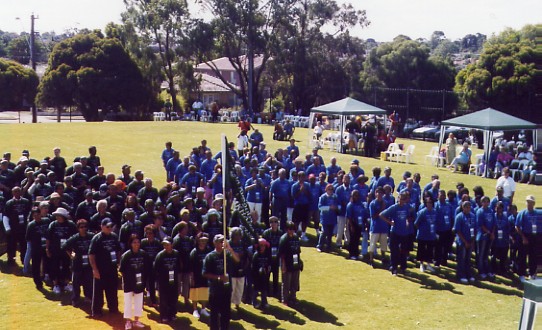 |
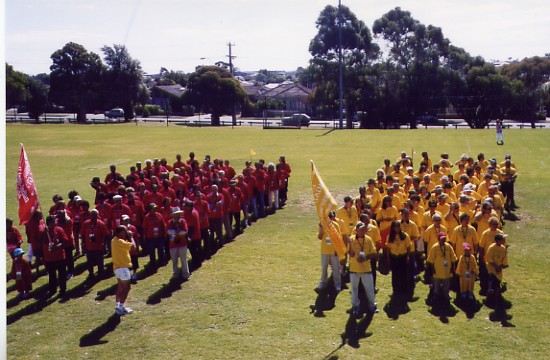 |
Noelene and Lionel are in yellow T-shirts, which I suspect is a matching "fix". I hasten to join my "red" team as they line up for a march past - banners held high and band blaring "Waltzing Matilda". We are colour co-ordinated all right, but as far as marching co-ordination goes, much remains to be desired. Those who have decided they would rather be part of cheer-leading groups (my Aunt Cynthia being one of them), sit in the shade of "shamianas" and stand up to yell encouragement as their "colours" raggedly file past. At the line up in front of the podium, I am amazed that so many people here still remember the words to "Jana Gana Mana" and are ready to belt this out fortissimo.
I am "athletically challenged" but I suffer no such handicap when it comes to exercising my gastric juices. And as I stroll into the main hall after the rigours of marching, my tummy gurgles appreciatively in response to the spicy smells from three stalls - South Indian dosas, idlis and vadas sizzling merrily at the first one; a North Indian selection of "chat", samosas, tandoori chicken, rotis and raita at the second halt - and finally a selection of Anglo-Indian cuisine (cooked by an Anglo-Indian catering outfit, no less) with a seductive array of potato chops, pan-rolls, jhal fraze, rice and "doll"!
No second guesses on which one I choose! The potato chops and pan rolls (which I'm too lazy to cook at home), accompanied by a chilled mango flavoured lassi, is sheer bliss. I am greedy enough to covet a rich kulfi ice-cream as a finishing touch, and although I suspect I'll probably suffer heartburn later on, I consider it well worth the price.
I rejoin the family gang outside where events on the field now follow in rapid succession: a three-legged race (won by our friend, the bubbly Priscilla Clements who leaps up and down in triumph), a mixed doubles sack race (everyone being vociferously encouraged to "get in the sack") followed by a tumultuous wheel-barrow race.
The next item, however, is a show stopper as far as we are concerned. Lionel Beardsley is "anchor-man" for a tug-of-war contest. The opposing red team quail at his considerable size - and as the whistle blows, Noelene, Bunny and I scream "Go! Go! Go". The yellow team are doing well until....uhhh, the rope breaks! A replacement rope is hastily put into place, but this time, it's too short for Lionel to tie around his waist and despite a gallant effort, the yellows are ignominiously defeated by the reds! We retire to our "shamiana", Lionel wiping his brow and hanging his head!
We pour ourselves ice cold drinks from our cooler, while out on the field a "Kabbadi" team is gearing up. Again surrounded by shrieking fans! As the sun begins to lower towards the horizon, the "colours" line up and winners receive their medallions.
Back inside the large indoor hall adjoining the playing fields, the band is revving up. Despite the exertions of the day, the floor is jammed with jiving couples. The scene is a shifting kaleidoscope - people of all shades, sizes and ages.
The Grand Ball is billed as the climax to the week's celebrations. And "grand" it certainly is. We file in to the magnificent Royal Exhibition Hall - three wings with arched ceilings and fan windows leading off from a central hall surmounted by a soaring dome. There are 3,100 people attending this gala tonight, and each one of them is attired in evening dress - the men in jackets, the women in sequinned, glittering ball gowns. Our table is dressed with fine linen, crystal wine glasses and eggshell china. The meal is a five course gourmet extravaganza, and the wine bucket is refilled just as fast as bottles are drained. Three bands take it in turn to accompany couples thronging the ballroom floor.
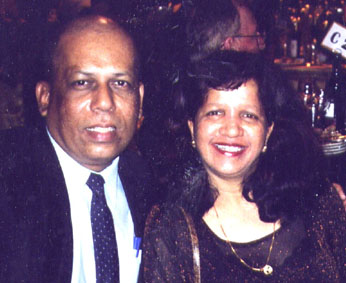 At the Ball: Harry and Jillian MacLure |
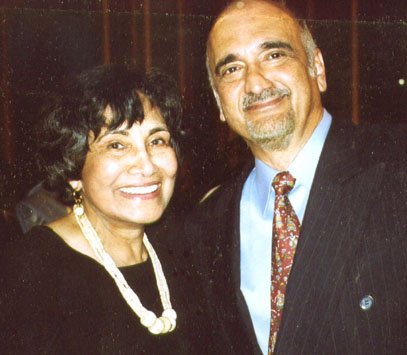 Grand Ball: Ellen and Blair Williams |
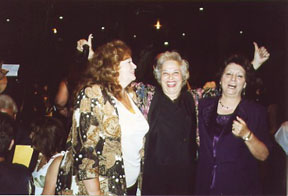 With old Calcutta friends, Linda & Helen (nee Blair) |
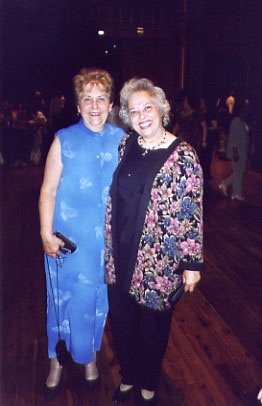 With ex-Prattler, Heather Forster (nee Vanderputt) |
Reunion magic is still at work here. An old school buddy, Heather Forster from the Pratt Memorial School in Calcutta, with whom I've since been in touch on e-mail, poses arm-in-arm with me for the benefit of my camera; and from a list of names posted in the foyer, I track down the table of two women Helen and Linda (nee Blair) who as little girls aged 5 and 8 lived in the apartment next door to us on Circus Avenue in Calcutta in the early '50s. We catch up with news of each other in a babble of excitement. At another table, I link up with a young woman whose family we knew in Gauhati, Assam in the late '50s. She was around six or seven at the time, but hugs me in recognition! As I get back to my table, I meet a couple who, intrigued by the fact that we share the same last name (Deefholts) drop by for a chat. I regret not having made a note of their first names as I'm amazed at the uncanny resemblance between (Derek?) Deefholts and my son, Glenn.
As coffee is served on our tables, the band launches into a selection of tunes which draws a delighted roar of recognition from the crowd. "The Ladies of Calcutta" is followed by "Woh to be in Yengland, now that Espring is Here" (sung originally by Bill Forbes and popularized via Radio Ceylon back in the '50s and '60s) and for the benefit of those hailing from Mumbai: "Bombay Mere Hai" and "Bombay Se Aya Mera Dosth". For good measure a sprinkling of lively and popular Goan (Konkani) melodies are thrown in as well.
I'd thought it would be a bit much to yank myself out of bed early enough to attend the Sunday ecumenical service at St. Patrick's Cathedral, but as it turns out, the effort is well worth it.
The church is packed. Anglo-Indians fill every pew and the specially tailored service is a pleasing amalgam of Catholic and Anglican ritual. That said, this is "high" church: incense, sung responses throughout the liturgy, a processional with clergy and acolytes in elaborate vestments and a pipe organ accompanying a full choir. And it is glorious! The music and voices echo against the rafters and the congregation joins in with enormous gusto to sing the selection of hymns, most of which are familiar and well-loved.
The closing Jam Session follows the cathedral service. Again, the inexhaustible energy of the Community is in evidence on the dance floor. Couples waltz, fox trot and jive. There is a sense of winding down now - the music is wistful as people wish old friends farewell and file out of the doors on their way home to so many different corners of the globe. Till, perhaps, next time around...
The organizers of the Melbourne Reunion - particularly Brian Brookes and his hard-working team - deserve mega kudos for re-kindling the flame of Anglo-Indian solidarity and hosting a week of unforgettable festivity and good cheer.
The 7th International Reunion is to be held in Toronto in 2007. Melbourne will be a hard act to follow, but I have no doubt that our folks in TO will rise splendidly to the challenge. I'm planning to be there - hope you are too.
Margaret Deefholts
2004
